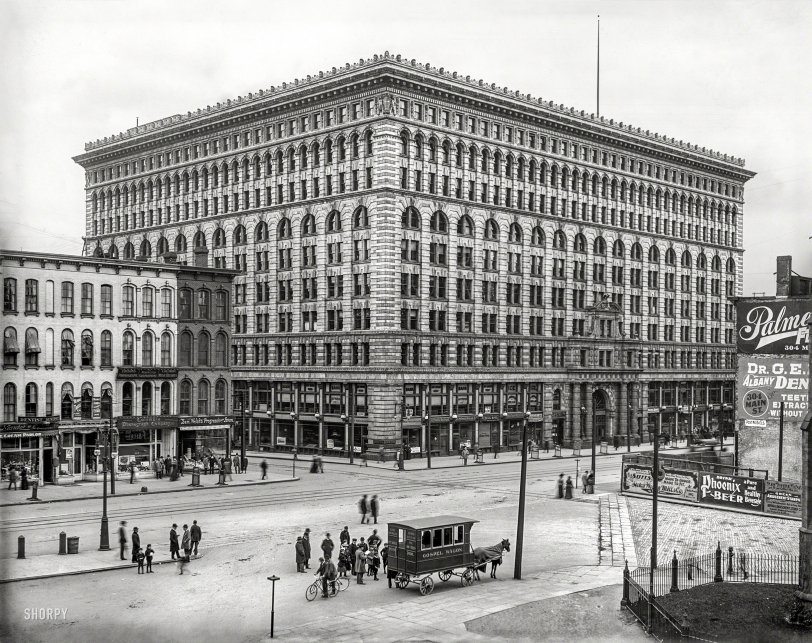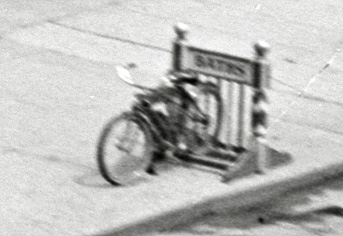


Framed or unframed, desk size to sofa size, printed by us in Arizona and Alabama since 2007. Explore now.
Shorpy is funded by you. Patreon contributors get an ad-free experience.
Learn more.

- Details, Details
- What's that building to the left of the tower?
- Coal Barges
- Bromo-Seltzer
- Inner harbor
- The Basin
- What a headache!
- Giant stepladder?
- Baldwin 62303
- Baldwin VO-1000
- Cold
- No expense spared
- Tough Guys
- Lost in Toyland
- And without gloves
- If I were a blindfolded time traveler
- Smoke Consumer Also Cooks
- Oh that stove!
- Possibly still there?
- What?!?
- $100 Reward
- Freeze Frame
- Texas Flyer wanted
- Just a Year Too Soon
- WWII -- Replacing men with women at the railroad crossing.
- Yes, Icing
- You kids drive me nuts!
- NOT An Easy Job
- I wonder
- Just add window boxes
Print Emporium
The Gospel Wagon: 1900

Buffalo, N.Y., circa 1900. "Ellicott Square Building." At the time of its completion 1896, the largest office building in the world. Our title for this post comes from lower down (and higher up). 8x10 inch glass negative. View full size.
Future office of Wild Bill Donovan
When this was taken, a local Buffalo teen named William Joseph Donovan was in St. Joseph's Collegiate Institute, with big dreams. He would enroll in Niagara University for two years before transferring to Columbia, where he received a B.A. and law degree. Returning to his hometown, "Wild Bill" went into private practice with Love & Keating in 464 Ellicott Square. He would remain there until he scratched the itch to form his own law firm in 1912. O'Brian, Hamlin, Donovan & Goodyear moved into the brand-new Iroquois Gas Building. Donovan's office grew dusty as he devoted more and more time to reawakening New York's militia and turning it, by 1917, into the "Fighting 69th" New York Infantry. As its colonel, Donovan became nationally famous, leading to a series of positions that would culminate as his appointment during World War II to begin the Office of Strategic Services - the forerunner of the CIA.
Progressive?
What does one sell in a "progressive" store?
["Progressive" as in the sense of "modern," as in this article, which seems unintentionally prescient. -tterrace]
I like the Gospel Wagon idea..
At least there not out knocking on your door during the Pittsburgh Steeler games.
Sidewalk Sign Design
I am interested if anyone knows the purpose of the signs placed along the sidewalks, which seem to be advertising above, and vertical bars of some sort below. Perhaps stops for public transportation, but why so many? And what are the bars for? A classic Shorpy mystery for me.
[A rare sight in early Shorpy street scenes: a bicycle rack, like the one in use here. -tterrace]

Ministering On Main Street
The Ellicott Square Building (283-309 Main Street) was completed in mid-1896 and still stands today. Six workmen died during the building's construction. Across the street was 304 Main, home to Palmer's Florist and the Albany Dental Parlor. “Sam. Welsh's Progressive Store” was the cigar store of brothers Samuel and Charles E. Welsh. They opened their 311 Main Street store in November of 1899, having previously operated the Progressive Cigar Store at 331 Main Street. Perhaps the Gospel Wagon Association thought that those buying cigars and phonographs needed to be exposed to something a little more “redeeming.”
Signs of the Times
There are at least five separate railroad ticket offices in the building: Erie; Pennsylvania; Buffalo Rochester and Pittsburgh; Chicago and Northwestern, and Nickel Plate. There may be more, but they're too fuzzy to read. Also like the interesting phonograph store selling Columbia and Edison cylinders and players (no they were not compatible).
Phoenix Reflected
The Phoenix Brewery, (a very popular name used through out the country), operated in Buffalo from 1887 to 1920, closed for prohibition from 1920 to 1934, operated again from 1934 to final closing in 1957. The title refers to the "BEER" reflection in one of the store windows across the street to the left.
























On Shorpy:
Today’s Top 5